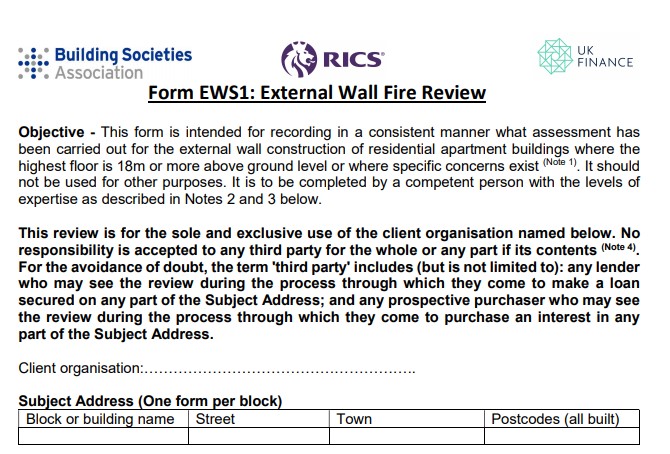EWS1 forms not required for buildings without cladding
Contents |
[edit] Introduction
An EWS1 form certifies that a residential building's external wall cladding system has been assessed by someone who is suitably qualified. It allows a valuation to be provided for a mortgage or re-mortgage on a property which features an external wall cladding system of uncertain make up in relation to fire risk.
A signed EWS1 form is prepared for an entire building stating either:
- The external wall materials are unlikely to support combustion; or
- Combustible materials are present and either the fire risk is sufficiently low that no remedial works are required, or the fire risk is high enough that remedial works are required.
[edit] Scope
EWS1 forms were initially introduced for buildings over 18m in height following the Grenfell Tower fire, however, changes in Government advice in January 2020, meant some residential buildings below 18m may also require an EWS1 form, for example if there is a significant amount of cladding on the building. Ref https://www.gov.uk/government/publications/building-safety-advice-for-building-owners-including-fire-doors
The Government subsequently took steps to alleviate the need for EWS1 forms for buildings without cladding. The removal of the requirement will also apply to other types of buildings without cladding. The agreement between the Government and the Royal Institution of Chartered Surveyors (RICS), UK Finance and the Building Societies Association (BSA) was reached on 21 November 2020.
Cladding might include; aluminium composite material (ACM), brick slips, high pressure laminate (HPL), metal composite material (MCM), metal sheet panels, render system, plastic, tiling systems, and timber or wood.
External wall systems are the combination of the external facing material (e.g. brick) and the insulation within the external wall. Ref https://www.gov.uk/government/publications/building-safety-programme-estimates-of-ews1-requirements-on-residential-buildings-in-england/building-safety-programme-estimates-of-ews1-requirements-on-residential-buildings-in-england
[edit] Additional building assessors needed
The Government is also providing additional funds to train more assessors, speeding up the valuation process for homeowners in cases where an EWS1 form is required. This is part of a wider Government-led solution to support those homeowners who have unsafe cladding on their buildings.
This training initiative will be delivered by RICS from January 2021 and will mean up to 200 additional assessors will be qualified to carry out the EWS1 assessment within a month, 900 within three months and 2,000 within six months.
RICS CEO Sean Tompkins said: "We recognise the acute market shortage of fire engineers to carry out EWS1 assessments and welcome the Government’s support on working with us to upskill other regulated professions, such as Chartered Building Surveyors, to create additional capacity in the market."
The EWS training programme was announced ahead of the Fire Safety Bill, which is set to receive Royal Assent in 2021. The EWS Assessment certificate programme is only suitable for Chartered Surveyors working in Building Surveying or Building Control in the UK.
[edit] Purpose of ongoing revisions
Building owners are legally required to undertake fire risk assessments on all blocks of flats following supplementary guidance published by the Government. Buildings over 18m or those which require specialist testing will still require a qualified fire safety engineer to carry out the EWS1 assessments. RICS will be working with lenders, valuers and fire safety bodies to develop new advice for surveyors.
This will enable surveyors to take a more proportionate approach and reduce the number of buildings where an EWS1 assessment is needed. The Government is seeking ways to address ongoing concerns around the availability of professional indemnity insurance. It supports industry’s progress on developing a portal where lenders, valuers and leaseholders will be able to find out if their building already has an existing EWS1, thereby reducing the demand for duplicate forms.
[edit] Related articles on Designing Buildings
- BS 8414 Fire performance of external cladding systems.
- Chartered surveyor.
- Cladding for buildings.
- External Fire Review Form EWS1.
- Fire risk assessments and historic buildings.
- Fire risk in high-rise and super high-rise buildings DG 533.
- Fire Safety Bill.
- Fire safety exclusions - the insurance position.
- High-rise building.
- High rise residential building.
- Medium-rise building.
- Royal Institution of Chartered Surveyors RICS.
- Site surveys.
- The Regulatory Reform (Fire Safety) Order 2005.
[edit] External resources
Quick links
[edit] Legislation and standards
Fire Safety (England) Regulations 2022
Regulatory Reform (Fire Safety) Order 2005
Secondary legislation linked to the Building Safety Act
Building safety in Northern Ireland
[edit] Dutyholders and competencies
BSI Built Environment Competence Standards
Competence standards (PAS 8671, 8672, 8673)
Industry Competence Steering Group
[edit] Regulators
National Regulator of Construction Products
[edit] Fire safety
Independent Grenfell Tower Inquiry
[edit] Other pages
Building Safety Wiki is brought to you courtesy of:






